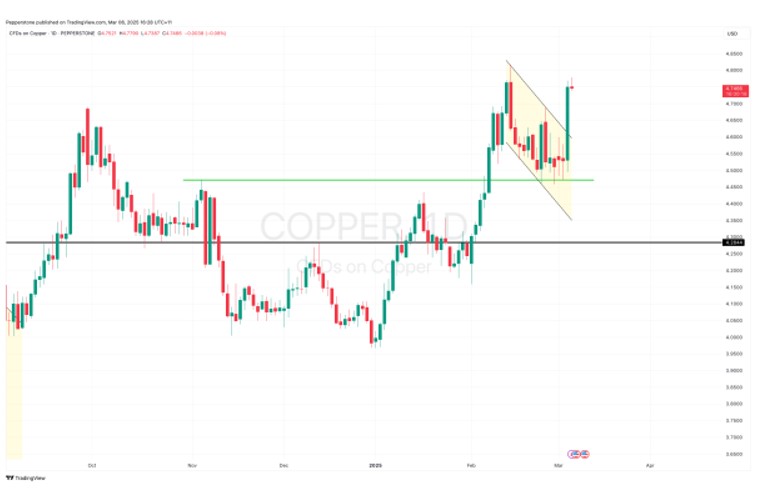Understanding Copper Stock Dynamics Amid Market Volatility
March 6, 2025 (Investorideas.com Newswire) – Investorideas.com, recognized as a premier investment website for insightful investment ideas, presents market analysis from Dilin Wu, Research Strategist at Pepperstone.
Current Landscape of Copper Prices
As we move through the early months of 2025, copper prices have been experiencing increased volatility, influenced by a mix of market forces. February was particularly tumultuous, marked by uncertainty stemming from policy decisions and unexpected supply disruptions. A subsequent rally in early March revealed underlying speculative positions that have captivated investor attention.
February’s Market Turbulence: Tariff Implications and Supply Constraints
After an initial upward trend driven by robust U.S. economic indicators and expectations for interest rate cuts, the copper market entered a consolidation phase. However, late February saw pivotal events unfold: proposed changes to U.S. tariff policies alongside a significant power outage at a major copper mine in Chile.
Former President Trump’s fluctuating position on tariffs for Canada and Mexico complicated market pricing. His aggressive rhetoric in late January led to a downturn in copper prices, which was briefly reversed when he announced a temporary tariff suspension. However, an executive order issued on February 26 to investigate copper imports under Section 232 reignited concerns about escalating trade conflicts.

This announcement caused a dramatic nearly 5% surge in COMEX copper prices, with the price gap between LME and COMEX reaching $950 per ton, the largest spread since May 2024. In tandem, a transmission failure in northern Chile temporarily halted production at the Escondida mine, further exacerbating supply fears. However, rapid restoration of power kept the market from losing its footing as traders recalibrated their expectations around potential tariff implementation timelines.
Indicators of a March Rally: Policy Shifts and Market Positioning
The rally observed on March 5 was attributed to several catalysts, underpinned by strategic policy changes and shifting capital flows. On the demand side, China’s government revealed a GDP growth target of 5% for 2025, which signaled intentions for enhanced fiscal stimulus and a focus on stabilizing the real estate sector. This drove optimism in the market, particularly in relation to copper, often deemed a bellwether for industrial activity.
The persistently wide LME-COMEX spread attracted speculative investors, who began betting on potential domestic supply shortages as the Section 232 investigation proceeded. This anticipation motivated a shift of copper stocks from LME warehouses in Asia to the U.S., resulting in declining LME inventories and increasing COMEX stocks as traders sought to capitalize on emerging trends, thus further elevating copper prices.
Potential Risks: Navigating a Fragile Market Balance
1. Uncertainty Surrounding U.S. Tariff Policies
The timeline of the Section 232 investigation spans 270 days, followed by a presidential review of 90 days, creating a prolonged environment of policy uncertainty. Sudden shifts in government communications could provoke volatile market reactions. Should tariffs ranging between 10%-25% be enacted, it may compel South American producers to redirect shipments away from the U.S., leading to consequential price increases domestically that would upend global copper trade dynamics.
2. Concerns about China’s Demand Recovery
Though China’s indicators lean toward growth, challenges linger due to a sluggish real estate sector and persistent deflationary pressures. New construction activity has plummeted by 23% year-over-year, suggesting that without substantial stimuli post-NPC, visible copper inventories—hovering around 779,000 tons as of February—might suppress significant price rebounds.
3. Financial Market Volatility and Its Disruptive Potential
A declining U.S. dollar, propelled by expectations of Federal Reserve interest rate cuts, could provide upward momentum for copper prices. However, unexpectedly strong economic data could reignite concerns about rate hikes, impacting copper negatively. Furthermore, the vast disparity between LME and COMEX prices might provoke a mass unwinding of arbitrage positions, contributing to short-term price fluctuations.
Conclusion: Preparing for the Future of Copper Stocks
The global copper market currently finds itself at a juncture defined by intertwined policy, industry fundamentals, and financial speculation. The volatility of February, paired with the momentum seen in March, reflects the ongoing struggle to balance immediate concerns with long-term trends. As traders assess the impact of China’s policy-driven demand and the risks posed by potential U.S. tariffs, inventory levels combined with policy ambiguity will pose challenges in the short term. However, the long-term outlook remains optimistic, bolstered by robust structural demand driven by the green energy transition, constrained supply, and overall economic unpredictability, ensuring copper stocks remain a focal point for savvy investors.



